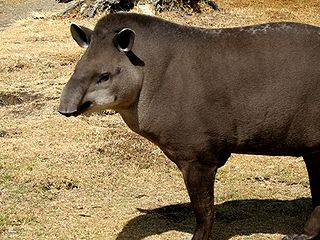 W
WOdd-toed ungulates, mammals which constitute the taxonomic order Perissodactyla, are animals—ungulates—who have reduced the weight-bearing toes to three or even one of the five original toes. The non-weight-bearing toes are either present, absent, vestigial, or positioned posteriorly. By contrast, the even-toed ungulates bear most of their weight equally on two of the five toes: their third and fourth toes. Another difference between the two is that odd-toed ungulates digest plant cellulose in their intestines rather than in one or more stomach chambers as even-toed ungulates, with the exception of Suina, do.
 W
WHallensia is an extinct genus of herbivore.
 W
WThe Helaletidae is an extinct family of tapiroid closely related and likely ancestral to the true tapirs, which contain Protapirus and all descendants. In alternative classifications, the Helaletidae is treated as a subfamily within Tapiridae, the Helaletinae.
 W
WThis is a list of odd-toed ungulate species by estimated global population. This list misses data on Tapirus terrestris, which has not yet been estimated.
 W
WPerissodactyla is an order of placental mammals composed of odd-toed ungulates—hooved animals which bear weight on one or three of their five toes with the other toes either present, absent, vestigial, or pointing backwards. Members of this order are called perissodactyls, and include rhinoceroses, tapirs, and horses. They are primarily found in Africa, southern and southeastern Asia, and Central America, and are found in a variety of biomes, most typically grassland, savanna, inland wetlands, shrubland, and desert. Perissodactyls range in size from the 1.8 m (6 ft) long Baird's tapir to the 4 m (13 ft) long white rhinoceros. Over 50 million domesticated donkeys and 58 million horses are used in farming worldwide, while four species of perissodactyl have potentially fewer than 200 members remaining. Three subspecies of the black rhinoceros, the Syrian wild ass subspecies of the onager, and the tarpan subspecies of the wild horse have gone extinct in the last 200 years.
 W
WPlagiolophus is an extinct genus of herbivore. The genus Plagiolophus is documented, almost solely in Western Europe, from the middle Eocene up to the mid Oligocene. The genus displays a wide range in size and weight.
 W
WRhinocerotoidea is a superfamily consisting of three family groups of odd-toed ungulates, two of which, the Amynodontidae and Hyracodontidae, are extinct. The only extant family group is the Rhinocerotidae, which survives as five living species. The extinct members of this superfamily are often called "rhinoceroses" alongside members of the family Rhinocerotidae, though they include genera, such as Paraceratherium, which do not closely resemble modern rhinoceroses.
 W
WTapiroidea is a superfamily of perissodactyls which includes the modern tapir. Members of the superfamily are small to large browsing mammals, roughly pig-like in shape, with short, prehensile snouts. Their closest relatives are the other odd-toed ungulates, including horses and rhinoceroses. Taxonomically, they are placed in suborder Ceratomorpha along with the rhino superfamily, Rhinocerotoidea. The first members of Tapiroidea appeared during the Early Eocene, 55 million years ago.